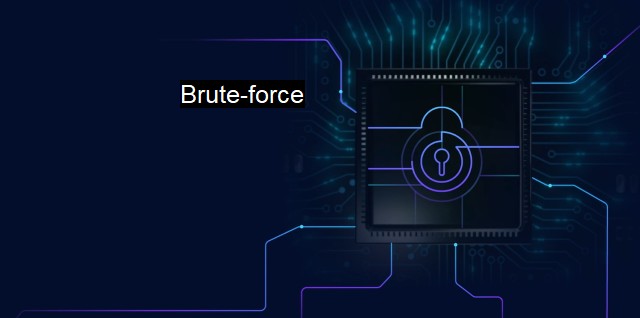What is Brute-force?
Breaking Down Defenses: The Ins and Outs of Brute-Force Hacking and Its Role in Cybersecurity
"Brute-force" is a commonly-used term, referring to a menacing type of cyberattack where an individual, usually a hacker, attempts to decode encrypted data such as passwords or Data Encryption Standard keys, not by exploiting a system’s weaknesses, rather by attempting all possible combinations until success is achieved. This particular sort of attack is conducted using trial and error, which is increasingly prevalent considering the current advancements in computer processing capabilities.Brute-force attacks are fundamental and simple to understand. Imagine a traditional lock and key. To unlock it without the key, you would try using every probable key until the correct one is discovered. This is exactly what a brute-force attack does; it tries to crack encryption or gain unauthorized access by trying each potential key until it finds one that correctly opens the digital lock, granting access to the system or the desired data.
For these attacks to be successful, they require considerable computational power and time. This is due to the tactical efforts for a majority of attacks being funneled particularly into making them speedy and undetectable. The level of security is commonly dependent on how unpredictable and complex the password, encryption key, or system in question is. Therefore, the more complex the system in place, the longer it'll take to break into it using brute-force.
Even though this type of cyberattack is remarkably old, it is still widely applied, serving as a grave threat to computers, networks, and Internet users. Attackers running a high number of quick tests to exploit specimens with poor security measures until an effective key is discovered are typically successful. Further, the expedition of brute-force attacks by cutting-edge technology such as machine learning and powerful hardware can enable hackers to swiftly run extensive combinations.
The primary defense against brute-force attacks in a cybersecurity framework is the utilization of long, complex, and hard-to-predict passwords. Complexity more than anything makes cracking a code by brute-force highly unlikely. an absolute prediction of successful defense is not necessarily guaranteed due to inevitably occurring guessing errors. To alleviate this, the usage of intricate software or hardware which actively monitor and limit too many unsuccessful login attempts or detect large-scale trial-and-error schemes is recommended.
Another defense tactic for brute-force attacks is the application of cryptographic hash functions, primarily for password storage. Instead of storing passwords directly, an antivirus program can store a hash value derived from the password. Even if breached, this implementation will not give away actual passwords directly to the intruders.
Yet it’s important to acknowledge that brute-force attacks are not exclusively proficient in just cracking passwords; They can also exploit encryption patterns and encrypted network communications. So, measures need to extend to the organization's vulnerable points like unencrypted areas, APIs, portals that can be utmost liable to the inconvenience.
In the context of antivirus, brute-force attack detection could sometimes prove difficult, especially if it uses a distributed network of computers to perform the attack. Nonetheless, cybersecurity advancements are continually rising to these challenges. Nowadays, advanced heuristics can detect patterns of brute-force attacks. Detection can also be improved via machine learning trained with patterns of normal and abnormal behavior. Algorithms can analyze requests' frequency coming from various IP addresses that help determine if a user or an application is systematically making login attempts.
Despite being one of the oldest types of cyberattacks, brute-force attacks continue to present a significant threat which has forced cybersecurity mechanisms and antivirus software to stay on their toes and continually evolve. Therefore, the robustness of the methods to counter brute-force attacks, particularly in areas such as password management, hash functions, and utilization of AI-driven antivirus programs, have never been more crucial.

Brute-force FAQs
What is Brute-Force?
Brute-Force is a hacking technique used to guess a password or encryption key by trying every possible combination of characters until the correct one is found.How does Brute-Force work in cybersecurity?
In cybersecurity, Brute-Force attacks are used to crack passwords or encryption by trying every possible combination until the correct one is found. Cybercriminals use this method to gain unauthorized access and steal sensitive information.How can I protect myself from Brute-Force attacks?
To protect yourself from Brute-Force attacks, you should use strong and complex passwords that are difficult to guess. Additionally, you can enable multi-factor authentication, which adds an extra layer of security by requiring a second form of authentication in addition to a password.What is the role of antivirus in preventing Brute-Force attacks?
Antivirus software can help prevent Brute-Force attacks by detecting and blocking malicious software that can be used to carry out these attacks. Additionally, some anti-malware programs have built-in features that can detect and block repeated login attempts and other suspicious activities.| | A | | | B | | | C | | | D | | | E | | | F | | | G | | | H | | | I | | | J | | | K | | | L | | | M | |
| | N | | | O | | | P | | | Q | | | R | | | S | | | T | | | U | | | V | | | W | | | X | | | Y | | | Z | |
| | 1 | | | 2 | | | 3 | | | 4 | | | 7 | | | 8 | | |||||||